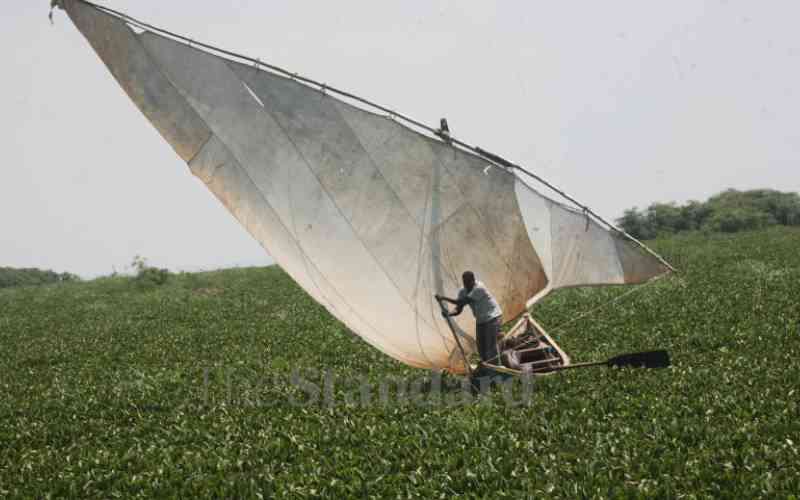
Different fish species including three types of Tilapia in Lake Victoria are on the verge of extinction.
Scientists at the Kenya Marine and Fisheries Research Institute (KEMFRI) have raised an alarm amid reports that overfishing by organised crime syndicates in Lake Victoria could drive 76 per cent of fish species to extinction.
The highly endangered and classified as species of concern are Tilapia species of Oreochromis niloticus (Nile Tilapia), Labeo victorianus, (Ningu) and Oreochromis variabilis (Mbiru), according to KEMFRI Director, Dr Christopher Aura who attributed the dangers facing the fish species to overfishing, habitat alteration, and competition from introduced alien species such as Nile Perch.
"The remaining populations are limited to a few isolated spots around Lake Victoria. Unfortunately, in most of these areas, the fishing community is not aware of the conservation status of the species are overexploiting it without notice," Dr Aura explained.
Fisherfolk on the shores of Lake Victoria confirmed Dr Aura's sentiments with James Okello, a fisherman saying the aforementioned species are rare nowadays and "can no longer be traced in the lake despite being a delicacy of many people."
Another fisherman, Paul Okwiri, observes that they mostly catch Tilapia through pure luck, and those caught are smaller in size and though "everyone wants to catch it, it's hard to find."
Dr Aura also notes that the effects of climate change have contributed to the decline of several fish species as the lake ecosystem can no longer offer a conducive environment for breeding and growth.
A report by The International Union for Conservation of Nature (IUCN) shows that Lake Victoria's freshwater ecosystems are highly threatened.

The report titled "Freshwater biodiversity in the Lake Victoria Basin indicates that 76 per cent of Lake Victoria's endemic biodiversity is at risk of extinction.
The report assessed the global extinction risk of 651 freshwater species, including fishes, molluscs, dragonflies, crabs, shrimps, and aquatic plants native to the Lake Victoria Basin.
It found that 20 per cent of these were threatened with extinction. Of the freshwater species assessed, 204 are endemic to the Lake Victoria Basin and three-quarters (76 per cent) of these endemics are at risk of extinction.
The report cited the example of the African Lungfish (Protopterus aethiopicus) whose numbers were declining in the lake basin largely due to overfishing, poor fishing practices, and environmental degradation as wetlands were being converted to agricultural land.
The report reads in part that the obliteration of the lungfish "could be a disaster as it is considered a delicacy by some local communities and is an important local medicinal product, used to boost the immune system and treat alcoholism."
It stated that among the primary threats to the lake's biodiversity are pollution from industrial and agricultural sources, over-harvesting of resources, and land clearance.
Invasive species also present an important threat to native biodiversity in the basin, affecting 31 per cent of all species and 73 per cent of threatened species.
Water Hyacinth was accidentally introduced to Lake Victoria from South America in the 1980s, and at its peak covered close to 10 per cent of the lake's surface. It reduces the oxygen and nutrient availability in the water column, which negatively affects native biodiversity.

"Invasive species also present an important threat to native biodiversity in the Basin, affecting 31 per cent of all species and 73 per cent of threatened species. The purple-flowered water hyacinth was accidentally introduced into the lake from South America in the 1980s, and at its peak, covered close to 10 per cent of the lake's surface," the study said.
However, Dr Aura notes that the introduction of Nile Perch in Lake Victoria had a major boost in the fishing industry but also drove hundreds of native species to near-extinction.
According to the report, the sharp rise in overharvesting of the lake's resources is due to more people opting for advanced modes of harvesting fish using outboard motors and trawlers in place of the less efficient paddle canoes.
The number of fishermen has also increased from 50,000 fishermen using about 12,000 fishing boats in the 1970s to over 200,000 people and 60,000 boats in 2015.
There are more than 2,000 new vessels appearing on the lake every year, according to the Lake Victoria Fisheries Organisation (LVFO), the body charged by the East African Community with safeguarding the lake's future.
In addition, clearance of land for agriculture, which supports more than 70 per cent of livelihoods in the Basin, has also been cited as a major threat to the lake, negatively affecting 44 per cent of the freshwater species and 17 per cent of threatened species.
 The Standard Group Plc is a multi-media organization with investments in media
platforms spanning newspaper print
operations, television, radio broadcasting, digital and online services. The
Standard Group is recognized as a
leading multi-media house in Kenya with a key influence in matters of national and
international interest.
The Standard Group Plc is a multi-media organization with investments in media
platforms spanning newspaper print
operations, television, radio broadcasting, digital and online services. The
Standard Group is recognized as a
leading multi-media house in Kenya with a key influence in matters of national and
international interest.



